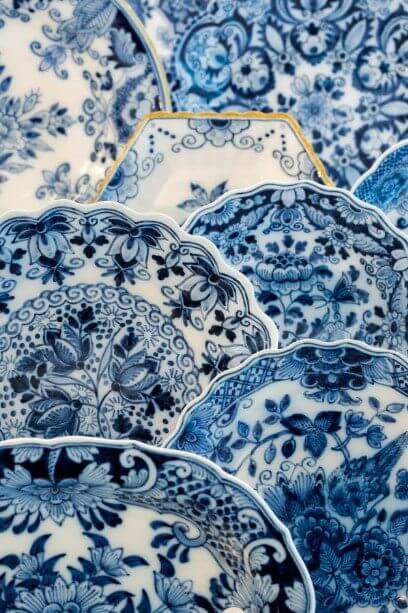For hundreds of years the Tichelaar family has been running its family business originating in the very North of The Netherlands. In family ownership since the early 16th century, the family has handed down its ceramic trade secret from one generation to another and boasts of world reknowned clients. Tharawat magazine explores the history of a family that started as brick makers and to this day produces some of the most recognised ceramic pieces in the world.
The Netherlands
The Netherlands is a founding member of the European Union, the OECD, and the World Trade Organisation. This country that, technically, lies under sea level, has its main industries in agriculture-related industries, metal and engineering products, electronic machinery, and equipment chemicals, petroleum, construction, micro-electronics, and fishing. Its main export destinations are Germany, Belgium, France, the UK, Italy and the United States. In 2009 The Netherlands were ranked 61st among the oil producing and 6th among the natural gas producing countries. Its GDP comprised $794.8 billion in 2009 and unemployment rose to 4.9% in 2009.
“Koninklijke Tichelaar Makkum” – Grown from the homeland
Travelling to the chilly North of the Netherlands leads visitors to Friesland, the northern-most province. Exposed to a harsh northern climate, the province is culturally rather different from the other provinces and next to Dutch, proudly maintains the use of its own language. Friesland was, and still is, a province famous for its cattle and its dairy products. In essence this has to do with the soil in parts of its territory. This ground is called ‘vette klei’ or fat clay and is alluvial or conquered from the sea. Other than enabling the province’s cows to famously grow larger than anywhere else, this soil was also the basis for another important industry: Brickyards. Thus, a little city in Friesland, called Makkum, came to be home of one of the oldest family businesses in Northern Europe, the ceramics manufacturer Koninklijke Tichelaar Makkum.
History
On a Spanish map from 1572, today’s location of Royal Tichelaar Makkum’s factory in Friesland is already marked as “bricaria” or brickyard. It is the oldest proof of the company’s over four centuries of uninterrupted ceramic production history. In around 1640, the Tichelaar family started working in the factory. Between 1688 and 1694 Freerk Jans Tichelaar took over the existing business together with his wife Jouwer Emes and transformed it into a more sophisticated glazing and brick manufacture. By 1670, the company focused almost entirely on producing practical domestic pottery for everyday use. In 1717 Freerk Jans and Jouwer Emes’ son, Yme took over the factory from his parents and managed it until 1770.
In 1868 Yme’s descendants, the brothers Jan and Jelmer Tichelaar joined forces to expand the business. They acquired a roof tiles factory near-by and for the first time branded their products with the family name “Gebrs. Tichelaar” (Brothers Tichelaar). As towards the end of the 19th century the demand for their core products, bowls and tiles, was declining they quickly diversified and developed more varied ranges of domestic pottery. Their expansion plans, however, were under great pressure due to competition from new factories working with steam engines in the United Kingdom and the industrialised production of metal tableware. In a pledge to remain competitive, the company started concentrating on more stylish and ornamental earthenware in 1890.
Institutional restructuring and the development of the ceramic and roof tile operations into a joint stock company marked the family business in the time after the First World War. However, this development was reversed after a while and the subsidiaries continued to be managed independently one from the other. After a long time of hardship during the Second World War, the new owner Jan Pieters Tichelaar foresaw the economic upturn that would follow. During the war he had been hoarding glazing material and was now ready to produce high quality products in a very short time. Throughout the 20th century the Tichelaar family stayed true to their origins and maintained the business’s reputation. Today, as during all of its 400 years of existence, the factory stands in the same spot where the first bricks were produced from the famous Makkum clay back in 1572.
Today
In 1998 the company decided to go new ways by switching from stock driven to on-demand manufacturing and produces mainly customised products. Today’s managing director Jan Tichelaar represents the 13th generation at the helm of the company and drives the development of the company further. Through an innovative spin on the family’s original business and a close collaboration with their customers, the company has maintained its leading role as internationally renowned producer of exclusive ceramics. Adapting the company’s workshops to suit a wide range of demands from the client base has proven to be the right decision.
Tichelaar now works with a network of international designers and architects, and their clients range from Museum of Art & Design in New York, which had its facade made by Tichelaar, to villas in Singapore. So do not hesitate next time you see a special tile or piece of innovative pottery to check its origin – it might well be that you are looking at a product of a 400-year-old family business.
Tharawat Magazine, Issue 8, 2010
















